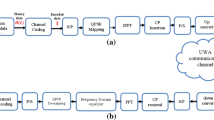Abstract
In this paper, we propose a novel signal detection algorithm to improve the performance of the multiple input multiple output (MIMO) space–time block code-orthogonal frequency-division multiplexing (STBC-OFDM) system in the underwater acoustic channel. Our special case for the underwater channel is the 114th station in the Caspian Sea. A model for an underwater MIMO-OFDM system is proposed first. Second, a signal coding method based on space–time block coding is employed. Finally, M-ZF, a modified signal detection algorithm, is then proposed for this system. Moreover, we compare M-ZF to ML, ZF, and MMSE. Another significant aspect of this paper is modeling an underwater acoustic channel using data from the Caspian Sea. In the modeling of the underwater channel, all actual conditions are considered. Ultimately, we evaluate the proposed algorithm in the underwater channel of the Caspian Sea. Simulation results demonstrate that the proposed algorithm has a lower time cost and superior bit error rate (BER) performance than others.

























Similar content being viewed by others
Notes
Most similarity.
References
Sing AC, Nelson JK, Kozat SS (2009) Signal processing for underwater acoustic communications. IEEE Commun Mag 47(1):90–96
Qiao G, Babar Z, Ma L, Liu S, Wu J (2017) MIMO-OFDM underwater acoustic communication systems_a review. Phys Commun 23:56–64
Laufen T, Xu X (2017) Digital underwater acoustic communications, 1st edn. Academic, New York, NY, USA
Jiang R, Cao S, Xue C, Tang L (2017) Modeling and analyzing of underwater acoustic channels with curvilinear boundaries in shallow ocean. In: 2017 IEEE International Conference on Signal Processing, Communications and Computing (ICSPCC). IEEE, Xiamen, China, pp 1–6
Etter PC (2018) Underwater acoustic modeling and simulation. CRC Press, Boca Raton, FL, USA
Wang J, Kong D, Chen W (2017) Cooperative multiple-input multiple-output communication for underwater acoustic sensor networks. Period Ocean Univ China 47(9):126–133
Wang J, Wang Q, Zhu F, Chen W, Han Y (2017) An energy-efficient algorithm based on the tradeoff diversity and multiplexing of MIMO for underwater sensor networks. Microelectron Comput 34(3):136–140
Abdallah M (2012) MIMO/OFDM convex optimization applications. In: 2012 IEEE Long Island Systems, Applications and Technology Conference (LISAT). IEEE, Farmingdale, NY, pp 1–5
Sampath H, Talwar S, Tellado J, Erceg V, Paulraj A (2002) A fourth-generation MIMO-OFDM broadband wireless system: design performance and field trial results. IEEE Commun Mag 40(9):143–149
Kim S (2012) Angle-domain frequency-selective sparse channel estimation for underwater MIMO-OFDM systems. IEEE Commun Lett 16(5):685–687
Chen P, Rong Y, Nordholm S, He Z, Duncan AJ (2017) Joint channel estimation and impulsive noise mitigation in underwater acoustic OFDM communication systems. IEEE Transac Wireless Commun 16(9):6165–6178
Bocus MJ, Agrafiotis D, Doufexi A (2018) Underwater acoustic video transmission using MIMO-FBMC. In: 2018 OCEANS-MTS/IEEE Kobe Techno-Oceans (OTO). IEEE, Kobe, Japan, pp 1–6
Zhou G, Li Y, He Y, Wang X, Yu M (2018) Artificial fish swarm based power allocation algorithm for MIMO-OFDM relay underwater acoustic communication. IET Commun 12(9):1079–1085
Tu K, Duman TM, Proakis JG, Stojanovic M (2010) Cooperative MIMO-OFDM communications: receiver design for Doppler-distorted underwater acoustic channels. In: 2010 Conference record of the forty fourth asilomar conference on signals, systems and computers. IEEE, Pacific Grove, CA, pp 1335–1339
Zhang L, Han J, Huang J, Zhang Q (2016) Iterative channel estimation and equalization for underwater acoustic MIMO SFBC OFDM communication. In: 2016 IEEE/OES China Ocean Acoustics (COA). IEEE, Harbin, China, pp 1–6
Zhou Y, Tong F (2019) Research and development of a highly reconfigurable OFDM MODEM for shallow water acoustic communication. IEEE Access 7:123569–123582
Nassiri M, Baghersalimi G (2018) Comparative performance assessment between FFT-based and FRFT-based MIMO OFDM systems in underwater acoustic communications. IET Commun 12(6):719–726
Liu B, Jia N, Huang J, Guo S, Xiao D, Ma Li (2022) Autoregressive model of an underwater acoustic channel in the frequency domain. Appl Acoust 185:108397
Zhang Y, Wang H, Li C, Chen X, Meriaudeau F (2022) On the performance of deep neural network aided channel estimation for underwater acoustic OFDM communications. Ocean Eng 259:111518
Onasami O, Feng M, Xu H, Haile M, Qian L (2022) Underwater acoustic communication channel modeling using reservoir computing. IEEE Access 10:56550–56563
Wilson W (1960) Equation for the speed of sound in sea water. J Acoust Soc Amer 32(10):1357
Grosso VAD (1974) New equation for the speed of sound in natural waters (with Comparison to Other Equations). J Acoust Soc Amer 56(4):1084–1091
Clay C, Medwin H (1977) Acoustical oceanography: principals and applications. John Wiley & Sons, New York, NY
Brekhovskikh LM, Lysanov YP, Lysanov JP (2003) Fundamentals of ocean acoustics. Springer Science & Business Media.
Author information
Authors and Affiliations
Corresponding author
Ethics declarations
Conflict of interest
The authors declare no competing interests.
Additional information
Publisher's note
Springer Nature remains neutral with regard to jurisdictional claims in published maps and institutional affiliations.
Rights and permissions
Springer Nature or its licensor (e.g. a society or other partner) holds exclusive rights to this article under a publishing agreement with the author(s) or other rightsholder(s); author self-archiving of the accepted manuscript version of this article is solely governed by the terms of such publishing agreement and applicable law.
About this article
Cite this article
Akhondi, M., Alirezapouri, M.A. A modified ZF algorithm for signal detection in an underwater MIMO STBC-OFDM acoustic communication system. Ann. Telecommun. 78, 491–507 (2023). https://doi.org/10.1007/s12243-023-00945-y
Received:
Accepted:
Published:
Issue Date:
DOI: https://doi.org/10.1007/s12243-023-00945-y




